Ground coffee is not just for brewing a delicious cup of joe. It has a multitude of uses and benefits beyond your morning routine. From skincare to gardening to household cleaning, the versatility of ground coffee is surprising and impressive. Discover the countless ways you can repurpose those leftover coffee grounds and unlock their hidden potential.
Key Takeaways:
- Ground coffee can be used for various purposes, from culinary creations to personal care products.
- When applied topically, ground coffee can provide skincare benefits such as exfoliation and anti-aging properties.
- Using coffee grounds as fertilizer can enhance plant growth and improve soil quality in gardening.
- Coffee grounds make an effective and eco-friendly cleaning scrub, removing grime and absorbing odors.
- Ground coffee can be utilized as a natural dye for fabrics and hair, providing a sustainable coloring option.
Culinary Uses of Ground Coffee
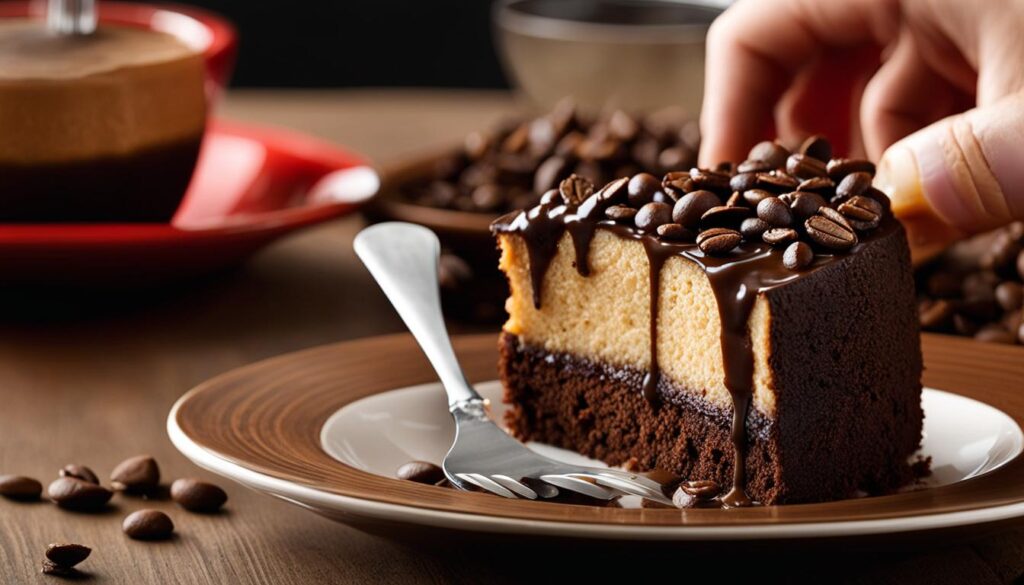
Ground coffee is not limited to brewing a classic cup of joe. Its unique flavors and aroma can be harnessed to enhance various culinary creations, adding depth and complexity to dishes. Whether you’re a seasoned chef or a passionate home cook, incorporating ground coffee into your recipes can open up a world of new flavors and dimensions.
One of the most popular culinary uses of ground coffee is as a rub for meats. The natural bitterness, smokiness, and earthiness of coffee can complement the savory flavors of beef, pork, or even poultry. Coffee-rubbed steaks are a prime example of how the boldness of coffee can elevate the taste of grilled meats to new heights.
But it doesn’t stop there. Ground coffee can also be integrated into desserts and baked goods, offering a delightful twist to traditional recipes. Think mocha muffins, espresso brownies, or coffee-infused ice cream. The combination of rich chocolate and the distinctive taste of coffee creates a harmonious blend that indulges the senses.
For those seeking unique ways to quench their thirst, ground coffee can even be infused into cocktails. Coffee liqueurs, espresso martinis, or cold brew vodka concoctions are just a few examples of how coffee can elevate your happy hour experience.
With ground coffee at your disposal, the possibilities are endless. Experiment with creating your own ground coffee recipes by incorporating it into sauces, marinades, or spice blends. The versatility of this ingredient allows you to explore new taste combinations and surprise your palate.
Unlock the full potential of ground coffee with these culinary hacks:
- Create a coffee-infused BBQ sauce for a tangy, smoky twist.
- Replace a portion of flour with finely ground coffee in chocolate-based desserts for a rich, robust flavor.
- Add a pinch of ground coffee to your chili or stew for an extra layer of complexity.
- Brew a strong pot of coffee and use it as a base for gravy or pan sauces.
- Sprinkle ground coffee on top of ice cream for an extra kick of flavor.
Remember, experimentation is key when it comes to culinary uses of ground coffee. Be bold, think outside the box, and let your taste buds guide you on a flavorful adventure.
Stay tuned for the next section as we explore the fascinating world of ground coffee for skincare.
Ground Coffee for Skincare
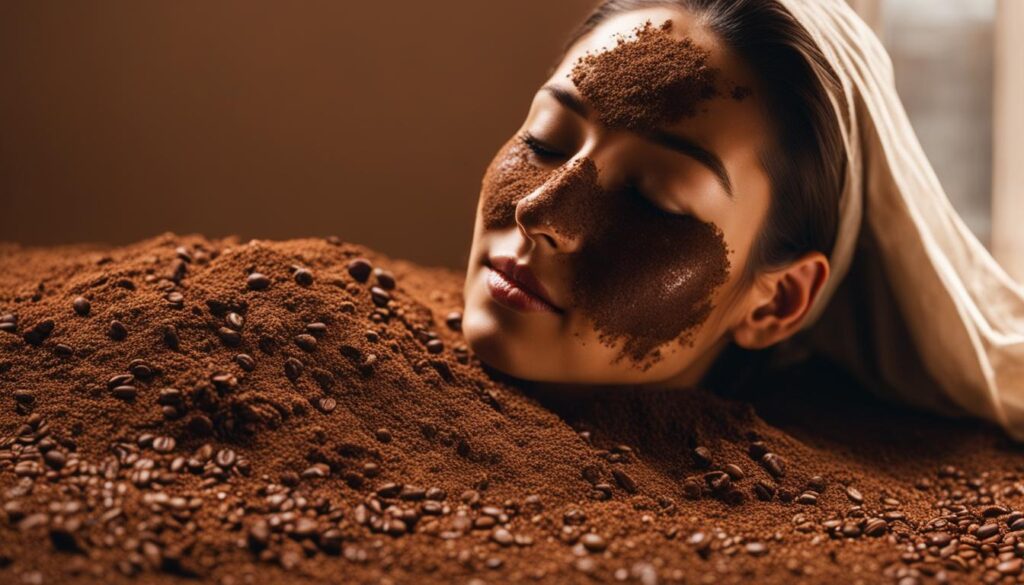
Ground coffee is not just for brewing a steaming cup of joe. It can also work wonders for your skin! When transformed into a natural exfoliant, ground coffee can help rejuvenate and revitalize your skin, leaving it looking fresh and radiant.
Exfoliation:
One of the primary uses of ground coffee in skincare is exfoliation. By mixing ground coffee with ingredients like water, honey, or coconut oil, you can create a gentle scrub that effectively removes dead skin cells, unclogs pores, and improves the overall texture of your skin.
Exfoliating with ground coffee can help reveal a brighter complexion, promote healthy skin cell turnover, and minimize the appearance of blemishes and dark spots. It can also enhance your skin’s ability to absorb other skincare products, allowing them to penetrate deeper and work more effectively.
The Benefits of Ground Coffee for Skin:
Ground coffee offers numerous benefits for your skin, thanks to its natural properties and components:
- Antioxidants: Coffee is rich in antioxidants, including caffeic acid, which can help neutralize free radicals and reduce the signs of premature aging. Antioxidants also protect your skin from environmental damage, promoting a healthier and more youthful glow.
- Exfoliation: The coarse texture of ground coffee acts as a physical exfoliant, gently buffing away dead skin cells and impurities. This helps unclog pores and prevent breakouts, giving you smoother and clearer skin.
- Anti-inflammatory properties: The anti-inflammatory properties of coffee can help calm irritation and redness, making it suitable for sensitive skin types.
- Caffeine stimulation: The caffeine present in ground coffee can stimulate blood circulation when applied topically, helping to brighten and tighten your skin.
How to Use Ground Coffee for Skincare:
To incorporate ground coffee into your skincare routine, follow these simple steps:
- Combine 1-2 tablespoons of ground coffee with your desired ingredients, such as water, honey, or coconut oil, to create a scrub.
- Gently massage the scrub onto damp skin, using circular motions.
- Focus on areas that require exfoliation, such as the face, elbows, knees, and heels.
- Rinse off the scrub with warm water.
- Follow up with a moisturizer to keep your skin hydrated and nourished.
Remember to perform a patch test before using the scrub on your face or body to ensure you do not have any adverse reactions. If you have sensitive skin, it’s best to consult with a dermatologist or skincare specialist before incorporating ground coffee into your routine.
“Using a natural exfoliant like ground coffee can be a great addition to your skincare regimen. It offers both physical and antioxidant benefits, helping to reveal smoother, brighter skin.” – Dr. Emily Hernandez, Dermatologist
| Benefits of Ground Coffee for Skincare | Ingredients for a DIY Coffee Scrub |
|---|---|
| Exfoliates dead skin cells | 1-2 tablespoons ground coffee |
| Unclogs pores | 1 tablespoon water, honey, or coconut oil |
| Promotes healthy skin cell turnover | – |
| Reduces signs of premature aging | – |
| Brightens and tightens the skin | – |
Ground Coffee for Gardening
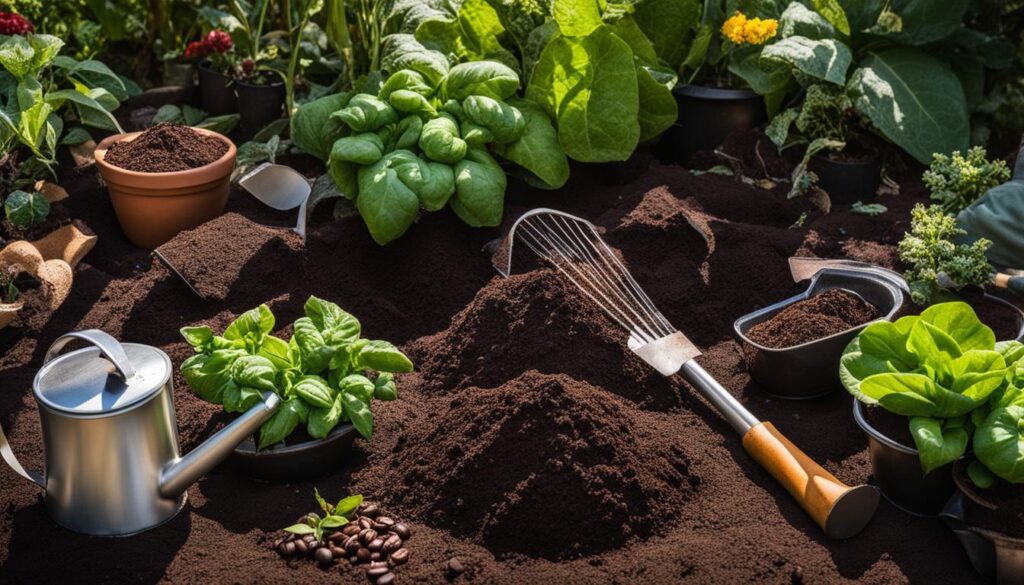
One of the natural and sustainable uses of coffee grounds is in gardening. Rather than throwing away your leftover grounds, consider repurposing them as a fertilizer to promote healthier plant growth and improve soil quality.
Coffee grounds contain essential nutrients that plants need, such as nitrogen, phosphorus, potassium, and calcium. These nutrients contribute to the overall health and vitality of your garden, helping plants thrive and produce an abundant harvest.
Additionally, coffee grounds have the ability to absorb heavy metals in the soil, preventing them from being taken up by plants and reducing the risk of contamination. This makes coffee grounds particularly beneficial in urban or industrial areas where the soil may contain pollutants.
Furthermore, coffee grounds act as a natural deterrent against common garden pests like slugs and snails. These critters are repelled by the acidity and scent of coffee grounds, making them less likely to feast on your plants.
To use coffee grounds as fertilizer in your garden, simply sprinkle them around the base of your plants or mix them into the soil. Be sure to use them in moderation, as excessive amounts of coffee grounds can alter the pH level of the soil.
Here are a few tips for using coffee grounds in your garden:
- Use coffee grounds in compost mixtures to enrich the organic matter and enhance the nutrient content.
- Mix coffee grounds with dried leaves or other organic materials to create a natural mulch that helps retain moisture and suppress weeds.
- Experiment with different plant varieties to determine which ones benefit most from coffee grounds.
Expert Tip:
“When using coffee grounds as fertilizer, it’s important to strike a balance. While coffee grounds offer many benefits, using them excessively can disrupt the pH level of the soil. Remember, moderation is key.”
By incorporating coffee grounds into your gardening routine, you can create a more sustainable and eco-friendly approach to plant care. Not only will you reduce waste, but you’ll also witness the positive effects of coffee grounds on the health and productivity of your garden.
Ground Coffee for Cleaning
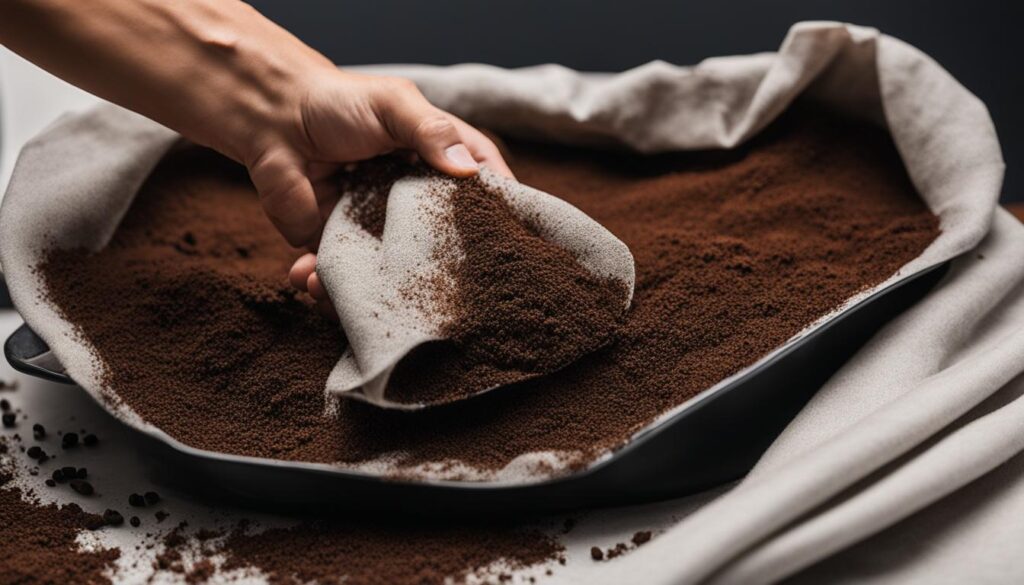
When it comes to household cleaning, you might be surprised to learn that your used coffee grounds can be a versatile and effective tool. The abrasive texture of coffee grounds makes them ideal for removing grime, grease, and stubborn stains from surfaces, utensils, and appliances in your home. Not only do they provide a natural and eco-friendly cleaning solution, but they also have odor-absorbing properties that can help neutralize unpleasant smells. With the right techniques, you can harness the cleaning power of coffee grounds to keep your home sparkling and fresh.
Here are some natural uses of coffee grounds for cleaning:
- Cleaning Surfaces: Sprinkle coffee grounds onto surfaces such as countertops, cutting boards, or stovetops, and use a damp cloth or sponge to scrub away grime and grease. The coarse texture of the coffee grounds helps to dislodge dirt while leaving a pleasant aroma behind.
- Deodorizing Shoes: Do you have lingering odors in your shoes? Place a small sachet filled with coffee grounds inside the shoes overnight to absorb unwanted smells. The coffee grounds will help eliminate unpleasant odors, leaving your shoes fresh and odor-free.
- Neutralizing Fridge Odors: Unpleasant odors can sometimes infiltrate your refrigerator. To combat this, place a small open container filled with coffee grounds in the back of your fridge. The coffee grounds will absorb and neutralize odors, keeping your refrigerator smelling fresh.
- Cleaning Utensils: Coffee grounds can be used to clean stainless steel utensils, such as knives or scissors. Simply rub the utensils with a small amount of coffee grounds and rinse thoroughly. This will help remove any stubborn stains or odors.
By using coffee grounds as a natural cleaning product, you not only reduce your reliance on harsh chemicals but also discover a cost-effective and eco-friendly solution to keep your home clean and fresh.
Cleaning with Coffee Grounds
| Item to be Cleaned | Method |
|---|---|
| Countertops, cutting boards, stovetops | Sprinkle coffee grounds, scrub with damp cloth or sponge, rinse |
| Shoes | Place sachet filled with coffee grounds inside shoes overnight for odor absorption |
| Refrigerator | Place open container of coffee grounds in the back of the fridge for odor neutralization |
| Stainless steel utensils | Rub with coffee grounds, rinse thoroughly |
Ground Coffee as a Natural Dye
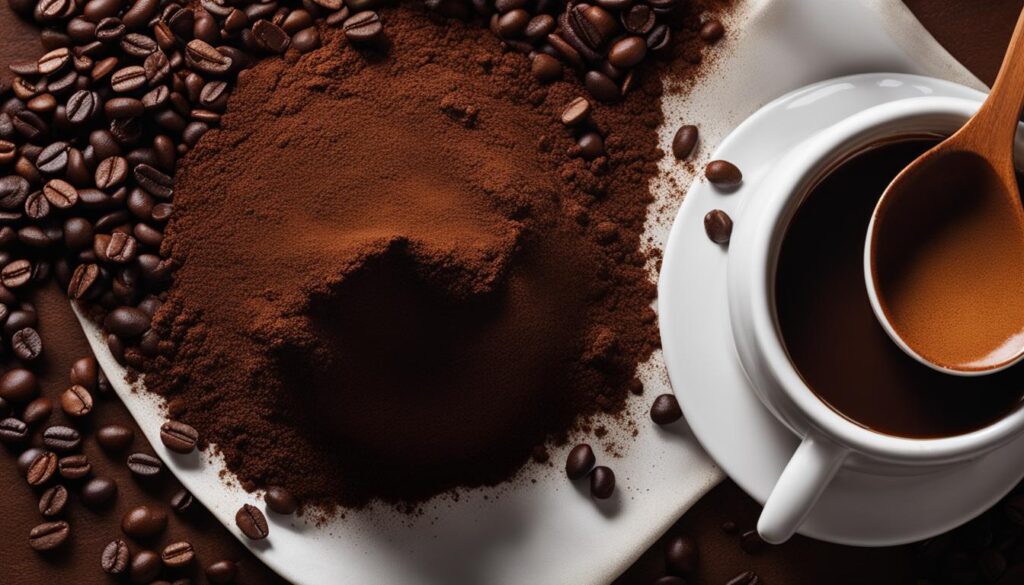
Have you ever considered using coffee grounds as a natural dye for your fabrics or hair? It’s a fascinating way to add unique, earthy tones without relying on synthetic dyes. By repurposing your coffee grounds, you can create sustainable and eco-friendly dyeing options.
When used as a fabric dye, coffee grounds can impart different shades of tan and brown to natural fabrics such as cotton, linen, or silk. The process is relatively simple but requires some experimentation to achieve the desired color intensity. Brewing and filtering the coffee grounds allow you to remove any large particles that may affect the dyeing process.
Using Coffee Grounds as Fabric Dye
- Gather your materials: fabric to be dyed, coffee grounds, a large pot, water, and a stirring utensil.
- Pre-wash the fabric to remove any chemical residues or sizing.
- In a large pot, combine the coffee grounds with water. The ratio of coffee grounds to water will depend on the desired color intensity and the amount of fabric you are dyeing.
- Bring the mixture to a boil, then reduce heat and simmer for 30 minutes to an hour.
- Remove the pot from heat and let the liquid cool.
- Strain the liquid to remove the coffee grounds.
- Immerse the fabric in the dye bath, ensuring it is fully submerged.
- Allow the fabric to soak for several hours or overnight, depending on the desired color intensity.
- Rinse the fabric thoroughly with cold water until the water runs clear.
- Hang the fabric to air dry, away from direct sunlight.
- Iron the dyed fabric to set the color.
Remember, the color obtained from coffee ground dyeing may vary depending on factors such as fabric type, coffee ground concentration, and dyeing time. It’s always a good idea to perform a small test on a fabric scrap before dyeing the entire piece.
Using Coffee Grounds for Hair Dye
Coffee grounds can also be used as a natural hair dye, offering temporary color highlights or subtle changes. It’s important to note that the color change may not be significant or long-lasting. Before using coffee grounds as a hair dye, consult a professional stylist to ensure suitability for your hair type and color.
In conclusion, coffee grounds provide a sustainable and natural option for dyeing fabrics and experimenting with temporary hair color. Whether you’re looking to add depth to your textiles or try out a unique hair shade, coffee grounds can offer an eco-friendly alternative. Embrace creativity and explore the fascinating world of ground coffee as a natural dye!
Ground Coffee in Personal Care Products
The antioxidants and anti-inflammatory properties of coffee can benefit the skin in various ways. Coffee-infused skincare products, such as masks, scrubs, and creams, can help improve blood circulation, reduce puffiness, and provide a youthful glow. The caffeine in coffee can also help stimulate hair growth when applied topically. Explore the range of personal care products that harness the benefits of coffee for healthier skin and hair.
| Benefits of Coffee in Skincare | Coffee-Infused Beauty Products |
|---|---|
|
|
The antioxidants present in coffee, such as chlorogenic acid and caffeic acid, can help protect the skin from free radicals and environmental damage. These antioxidants also have anti-aging properties, helping to reduce the appearance of fine lines and wrinkles. Coffee’s natural exfoliating properties help slough off dead skin cells, revealing a brighter and smoother complexion.
Coffee-infused beauty products, when used topically, can also improve blood circulation and reduce puffiness. The caffeine in coffee helps constrict blood vessels, reducing redness and inflammation. This can be particularly beneficial for those with acne, rosacea, or sensitive skin.
For those looking to promote hair growth, coffee-infused hair products can help stimulate the hair follicles and improve blood flow to the scalp. This can lead to thicker, healthier hair and potentially reduce hair loss. Coffee can also add shine and luster to the hair, enhancing its overall appearance.
When incorporating coffee-infused personal care products into your routine, it is important to choose high-quality, natural formulations. Look for products that are free from harsh chemicals and additives, and opt for those that use organic, fair-trade coffee beans. Additionally, it’s always a good idea to patch test new products to check for any potential allergies or sensitivities.
To reap the full benefits of coffee-infused beauty products, it’s recommended to use them consistently and in combination with a comprehensive skincare and haircare routine. This may include cleansing, toning, moisturizing, and protecting your skin from the sun. Remember, everyone’s skin is unique, so what works for others may not work for you. Don’t be afraid to experiment with different coffee-infused products and find what works best for your individual needs.
With the numerous benefits of coffee in skincare and haircare, it’s no wonder that coffee-infused beauty products have become increasingly popular. Whether you’re seeking a natural exfoliant, a way to reduce puffiness, or a way to promote healthier hair growth, coffee can be a valuable addition to your personal care routine. Embrace the power of ground coffee and unlock its potential for healthier skin and hair.
Selection and Storage of Ground Coffee

When it comes to selecting quality ground coffee, there are several factors to consider. By choosing the right beans and storing them properly, you can ensure a flavorful and enjoyable coffee experience. Here are some tips for selecting and storing ground coffee:
- Opt for high-quality beans: Look for reputable coffee brands that prioritize quality sourcing and ethical practices. Consider the taste profile you prefer, whether it’s a bold and robust flavor or a milder and smoother blend. Different regions and processing methods can also influence the taste, so explore the options available and find your perfect match.
- Roast level: Determine your preference for the roast level—light, medium, or dark. Each roast level brings out different flavors and aromas, so choose one that aligns with your taste buds. Light roasts tend to be more acidic and retain the natural flavors of the beans, while dark roasts have a stronger, smokier taste.
- Consider the origin: Coffee beans from different regions have distinct flavor profiles. Whether it’s the fruity and floral notes of Ethiopian coffee or the chocolatey undertones of Colombian coffee, exploring the origins can add excitement and variety to your coffee routine.
- Storage: To maintain the freshness of your ground coffee, proper storage is essential. Keep it in an airtight container to prevent exposure to air, moisture, and light. Find a cool, dark place for storage, avoiding areas near heat sources or in direct sunlight. Moisture and heat can compromise the flavor and quality of the coffee over time.
Benefits of selecting quality ground coffee
Choosing high-quality ground coffee provides numerous benefits. With carefully selected beans, you can enjoy a rich and flavorful cup of coffee that satisfies your taste preferences. The right roast level and origin can enhance the complexity of flavors, giving you a unique and enjoyable coffee experience. Additionally, properly storing your ground coffee ensures that it stays fresh for an extended period, allowing you to savor the delicious aromas and flavors with every cup.
Remember, selecting and storing ground coffee is just as important as the brewing process itself. By paying attention to these details, you can unlock the true potential of your coffee beans and create a superior coffee-drinking experience.
| Benefits of selecting quality ground coffee | Proper storage guidelines for ground coffee |
|---|---|
|
|
Tips and Cautions for Using Ground Coffee

When using ground coffee for various purposes, it is essential to keep a few tips and cautions in mind. Follow these recommendations to make the most of your ground coffee:
- Avoid using coffee grounds on delicate surfaces or utensils that may be easily scratched. Coffee grounds have a coarse texture that can potentially damage sensitive materials. Stick to using them on sturdy surfaces like countertops or non-porous utensils.
- Be cautious when using coffee grounds on pets, as caffeine can be toxic to them. While coffee grounds may have benefits for plants and the environment, it is essential to keep them away from pets. Caffeine can be harmful to animals, so it’s best to avoid exposing them to coffee grounds altogether.
- Practice moderation when consuming coffee, as excessive amounts can have negative health effects. While coffee offers several health benefits when consumed in moderation, excessive caffeine intake can lead to negative side effects. Limit your coffee consumption to a reasonable amount and be mindful of your caffeine sensitivity.
“Using coffee grounds responsibly and being aware of potential hazards ensures a safe and enjoyable experience with this versatile ingredient.”
By following these tips and cautions, you can make the most of your ground coffee while minimizing any potential risks.
Historical and Origin Significance of Ground Coffee
Coffee has a long and fascinating history that dates back centuries. The origins of ground coffee can be traced back to various parts of the world, where different cultures developed their unique methods of preparing and consuming this beloved beverage.
The story of ground coffee begins with the discovery of the coffee plant’s energizing properties, likely in the highlands of Ethiopia. Legend has it that a goat herder named Kaldi noticed his goats becoming more lively after nibbling on the bright red berries of a particular tree. Intrigued, he tried the berries himself and experienced a similar surge of energy.
From Ethiopia, the popularity of coffee spread to the Arabian Peninsula and the Middle East. Arab traders began cultivating and trading coffee, and it gained significant cultural and ceremonial importance in Islamic communities. The art of roasting and grinding coffee beans was perfected, leading to the creation of a rich, aromatic brew.
During the 15th century, coffee made its way to Europe, brought by traders and travelers. Initially, it was seen as an exotic beverage favored by the elites. The first European coffeehouse opened in Venice in 1645, marking the beginning of the coffeehouse culture that would thrive throughout the continent.
The popularity of ground coffee continued to soar, and coffee cultivation expanded to various colonies around the world. The Dutch introduced coffee to Indonesia, which became a major exporter of coffee beans. The French planted coffee in their colonies, particularly in the Caribbean and Africa. Meanwhile, the British played a significant role in establishing coffee plantations in India and Ceylon (now Sri Lanka).
As coffee production expanded, so did the demand for a more convenient brewing method. Traditional methods, such as steeping whole beans or using improvised grinders, gave way to the invention of coffee grinders and the grinding of beans into a finer consistency.
The Evolution of Ground Coffee Production
In the early days, coffee was often ground using traditional mortar and pestle or stone mills. However, as demand for ground coffee grew, more efficient and precise grinding methods were developed.
In the 19th century, industrialization revolutionized coffee production. The invention of the steam-powered grinding mill and the Burr grinder allowed for faster and more consistent grinding, producing evenly ground coffee particles.
Today, modern technology has further advanced ground coffee production. Electric grinders, both blade and burr, are widely used in homes and coffee shops. These grinders offer adjustable settings to achieve the desired fineness or coarseness, allowing coffee lovers to tailor their brews to their preferences.
| Historical Milestones | Significance |
|---|---|
| The discovery of coffee’s energizing properties in Ethiopia | Beginning of coffee consumption and cultivation |
| Introduction of coffee to the Arabian Peninsula and the Middle East | Development of the art of roasting and grinding coffee |
| Spread of coffee to Europe and the opening of the first coffeehouse in Venice | Emergence of the European coffeehouse culture |
| Expansion of coffee cultivation in colonies worldwide | Increase in coffee production and exports |
| Invention of coffee grinders and the grinding of beans into finer consistency | Improvement in the convenience and quality of coffee brewing |
| Industrialization and the invention of steam-powered grinding mills | Increase in the efficiency and consistency of ground coffee production |
| Modern technology and the widespread use of electric grinders | Precision and customization in grinding coffee beans |
Ground coffee has a rich history intertwined with cultural traditions and regional practices worldwide. From its humble beginnings in Ethiopia to becoming a global phenomenon, ground coffee has evolved alongside human innovation and taste preferences. Exploring the origins and historical significance of ground coffee allows us to appreciate the diverse and fascinating journey of this beloved beverage.
Key Components and Properties of Ground Coffee
Ground coffee is a complex substance that contains a variety of chemical compounds and components, contributing to its distinctive flavor, aroma, and potential health benefits. Understanding the key components and properties of ground coffee can deepen your appreciation for this versatile ingredient.
The Chemical Composition of Coffee
Coffee is composed of numerous chemical compounds that contribute to its unique characteristics. One of the most well-known components is caffeine. Caffeine is a natural stimulant that can have a variety of effects on the body, including increased alertness and improved focus.
In addition to caffeine, ground coffee contains a range of antioxidants. Antioxidants are substances that help protect the body against damaging free radicals, which can contribute to oxidative stress and chronic diseases, such as heart disease and certain types of cancer. These antioxidants in coffee include chlorogenic acid, caffeic acid, and quinic acid.
Phenols are another class of compounds found in coffee. Phenols are known for their potential health benefits, including anti-inflammatory and anti-cancer properties. Coffee also contains other bioactive compounds, such as trigonelline, diterpenes, and melanoidins, which can contribute to its flavor and potential health effects.
Flavor and Aroma Profiles of Ground Coffee
The flavor and aroma of ground coffee can vary depending on factors such as the origin of the coffee beans, the roast level, and the brewing method. Different varieties of coffee beans, such as Arabica and Robusta, have distinct flavor profiles. Arabica beans are often described as having milder, more nuanced flavors, while Robusta beans can have a stronger, more bitter taste.
The roast level of the coffee beans also plays a role in determining the flavor and aroma of the ground coffee. Light roasts tend to have a brighter and more acidic taste, while dark roasts can be bolder and have a richer, more caramelized flavor. Medium roasts offer a balance between the two.
When ground coffee is brewed, the extraction process releases the aromatic compounds present in the beans. These compounds contribute to the enticing aroma that fills the air when coffee is brewed. The aroma can be described as floral, fruity, nutty, chocolatey, or even spicy, depending on the specific coffee beans and their unique characteristics.
Health Benefits of Ground Coffee
The components found in ground coffee have been associated with several potential health benefits. Research suggests that coffee consumption may be linked to a reduced risk of various conditions, including type 2 diabetes, liver disease, Parkinson’s disease, and certain types of cancer.
However, it’s important to note that the potential health benefits of coffee are not solely attributed to any single component. Rather, it’s the intricate interplay between the various chemical compounds that make coffee a complex and intriguing substance.
By understanding the key components and properties of ground coffee, you can appreciate the diverse range of flavors, aromas, and potential health benefits it offers. The chemical composition of coffee is a testament to its complexity and the impact it can have on our senses and well-being.
Best Practices for Ground Coffee Storage
To ensure the best quality and flavor of ground coffee, proper storage is crucial. Storing ground coffee in the right way helps preserve its freshness and extend its shelf life, allowing you to enjoy the full flavors and aromas for a longer period.
First, it’s important to store ground coffee in an airtight container to prevent exposure to air, moisture, and other external factors that can compromise its taste. An airtight container creates a barrier that keeps the coffee beans protected from oxidation and moisture absorption, which can lead to staleness.
Additionally, the storage location is crucial. Keep the container in a cool, dry place away from direct sunlight. Heat and light can accelerate the deterioration of the coffee’s flavor compounds, so it’s best to avoid storing it near the stove, oven, or windowsill. A pantry or cupboard is an ideal spot.
While some people may be tempted to store their ground coffee in the refrigerator or freezer, this is not recommended. Coffee can absorb odors and flavors from other food items in the fridge, affecting its taste. Freezing coffee can also lead to moisture buildup when it’s thawed, resulting in a loss of flavor and aroma.
For the freshest taste, consider buying whole bean coffee and grinding it just before brewing. This allows you to maximize the flavor potential of the coffee beans and ensures a more robust and aromatic cup of coffee.
By following these best practices for storing ground coffee, you can preserve its freshness, extend its shelf life, and indulge in a delightful coffee experience every time.
FAQ
What are some uses and benefits of ground coffee?
Ground coffee can be used in various ways, including culinary creations, skincare, gardening, cleaning, and more. It offers benefits such as enhancing flavors, exfoliating the skin, promoting plant growth, and acting as a natural cleaning scrub.
How can ground coffee be used in recipes?
Ground coffee can be used as a rub for meats, incorporated into desserts and baked goods, or infused into cocktails. It adds depth and flavor to dishes, creating new dimensions in your culinary creations.
What are some skincare benefits of using ground coffee?
When used as a scrub, ground coffee can remove dead skin cells, unclog pores, and improve skin texture. The antioxidants present in coffee may also reduce premature cell aging and boost collagen levels, contributing to healthier skin.
How can coffee grounds be used in gardening?
Coffee grounds contain essential nutrients that promote plant growth and improve soil quality. They can be used as a natural fertilizer, help absorb heavy metals in the soil, and deter pests like slugs and snails.
Can coffee grounds be used for cleaning?
Yes, coffee grounds can be used as a natural cleaning scrub to remove grime and grease from surfaces, utensils, and appliances. They also have odor-absorbing properties, making them useful for neutralizing unpleasant smells in the kitchen or shoes.
Can ground coffee be used as a natural dye?
Yes, coffee grounds can be used as a natural dye for fabrics, imparting different shades of tan and brown. They can also be applied to hair for subtle color highlights or temporary changes, although the result may not be significant or long-lasting.
Are there any personal care products that use ground coffee?
Yes, coffee-infused skincare products, such as masks, scrubs, and creams, utilize the antioxidants and anti-inflammatory properties of coffee to improve blood circulation, reduce puffiness, and provide a youthful glow. Coffee can also stimulate hair growth when applied topically.
What should I consider when selecting and storing ground coffee?
Opt for high-quality beans and consider your preferred taste profile. Look for a roast level that suits your taste and store ground coffee in an airtight container in a cool, dark place to maintain freshness. Avoid exposure to moisture and excessive heat.
Are there any tips or cautions when using ground coffee?
Be cautious when using coffee grounds on delicate surfaces or pets, as caffeine can be toxic to them. Also, practice moderation when consuming coffee, as excessive amounts can have negative health effects.
What is the historical and origin significance of ground coffee?
Ground coffee has evolved from traditional coffee preparation methods across different cultures. It has a rich history and cultural significance, with unique flavors and styles originating from various regions around the world.
What are the key components and properties of ground coffee?
Ground coffee contains caffeine, antioxidants, phenols, and other bioactive compounds that contribute to its flavor, aroma, and potential health benefits. The levels of these components may vary depending on brewing methods and bean origin.
How should ground coffee be stored for the best quality?
Store ground coffee in an airtight container in a cool, dry place away from direct sunlight. Avoid storing it in the refrigerator or freezer as moisture can deteriorate its quality. It is recommended to purchase whole beans and grind them just before brewing for the freshest taste.






